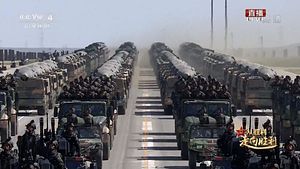China’s People’s Liberation Army (PLA) recently celebrated its 90th anniversary with a large parade of personnel and equipment at the Zhurihe training base in Inner Mongolia. While the vast majority of systems in the parade are for conventional combat, there were two nuclear-capable ballistic missiles on display, the DF-26 and DF-31AG.
China’s approach to nuclear deterrence and changes in its nuclear forces have not received much attention, given the rapid and dramatic development of North Korea’s nuclear weapons and ballistic missiles. But developments in China’s nuclear deterrent should not be ignored given the flash points that could draw the United States into armed conflict with China.
The most important flash point in the near term is the Korean Peninsula, where a conflict between the United States and North Korea risks drawing in China. The South China Sea and Taiwan, two other historic flash points, are relatively calm at the moment, but Trump’s decision to continue the military aspects of Obama’s “pivot to Asia” increases the likelihood these areas will not remain peaceful for long.
China’s nuclear weapons play an important role in these areas of potential conflict. The technical characteristics of the DF-26 and DF-31AG provide valuable insight into the future of China’s nuclear deterrent.
According to the latest Department of Defense report to Congress on China’s military, “The DF-26 is an intermediate-range ballistic missile which is capable of conducting conventional and nuclear precision strikes against ground targets.” A dual-capable ballistic missile can bolster deterrence by increasing the risks of strikes against missile bases. In a conflict with China, it would be relatively easy and operationally beneficial for the United States to strike fixed targets that support China’s combat forces. However, the ambiguity surrounding the DF-26 means that a strike intended for China’s conventional ballistic missiles could end up destroying some nuclear-armed missiles instead, which raises the chance of counter-escalation by China.
The DF-31AG, meanwhile, is a modified version of the DF-31A road-mobile intercontinental ballistic missile (ICBM). The primary difference between the DF-31AG and DF-31A is transporter erector launcher (TEL) vehicle that transports and fires the missile. While the DF-31A’s TEL could only travel on paved roads, the DF-31AG’s TEL can travel over more rugged terrain. The ability to go off-road improves the survivability of the missile by creating a larger area of potential launching sites. A missile that is not dependent on roads for transport and launch is much more difficult to find and therefore more likely to survive long enough to launch a retaliatory strike. This logic is behind North Korea’s decision to develop tracked TELs for its Pukguksong-2 ballistic missile.
Since China is bound to a no first use nuclear doctrine, leaders in Beijing need to be confident that their nuclear forces can survive a nuclear first strike and retaliate in order for deterrent threats to be credible. After China began modernizing its nuclear forces in the 1990s, its land-based ICBM force has focused on building mobile, solid-fueled missiles in a push to maximize survivability while also keeping the force relatively small. The DF-31AG’s new TEL is a major improvement over the DF-31A because it can travel over more terrain, thereby increasing mobility, complicating adversary targeting, and reducing the number of missiles that are likely to be destroyed in a first strike.
It is important to understand how improvements in U.S. missile defense capabilities influence the development of China’s nuclear forces. China’s nuclear doctrine assumes that its nuclear forces will be degraded by a first strike. If the United States has a robust missile defense capability that can absorb a ragged retaliation then it would have a decisive strategic advantage over China. The steady increase in the number of missile defense systems deployed in East Asia in recent years, ostensibly in response to the North Korean threat, are of great concern to Beijing. Additionally, North Korea’s ICBM creates political support for improvements to the Ground-Based Midcourse Defense system, which protects the United States from ICBM attack and reduces the credibility of China’s deterrent.
The DF-26 and DF-31 AG indicate that Beijing will pursue a qualitative approach to bolstering its nuclear deterrent in the face of improved U.S. missile defense capabilities. Rather than building up a large number of nuclear weapons that could absorb losses from a first strike and still overwhelm missile defenses, China hopes to keep its deterrent viable through ambiguity and survivability. The ambiguity of whether or not a DF-26 unit has conventional or nuclear warheads makes it risky to target these missiles in a first strike, and the extra mobility of the DF-31AG’s improved TEL increase the numbers of targets that missile defenses have to defeat.
While there is nothing inherently bad about increasing survivability, intentionally creating ambiguity as a means of bolstering deterrence creates risks in times of crisis. Chinese strategists hope that ambiguity will create unacceptably high risks for the United States, but this does not guarantee that U.S. decision-makers will restrain themselves and behave as the Chinese hope. If U.S. policymakers continues to place a high value on missile defenses as a way to manage the North Korean problem, they must understand the risks that such an approach creates for U.S.-China stability in the long-run.
Eric Gomez is a policy analyst for defense and foreign policy studies at the Cato Institute.

































